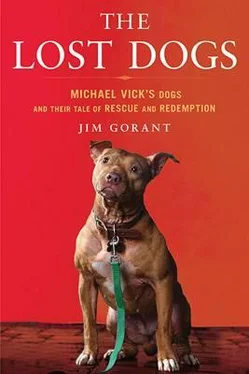It was an exhausting schedule, both physically and emotionally, but the dogs provided the motivation. She could now look at each one and see how they all were progressing. Little Red Hair was a nervous dog with a crosshatch of scars running down her snout and filed-down teeth that led some to theorize that she had been used as a bait dog-essentially a sparring partner for the more skilled and aggressive fighters.
When Rattay visited the shelter where Little Red lived, she wrote this: “Was unwilling to be coaxed up front, but while I was talking to Curly in the next kennel, she would come up and look at me. As soon as I talked to her she skittered to the back of her run.” On Rattay’s first day on the job, Little Red was curious but far too scared to even take the treats Rattay was offering.
But on the third day there was already a change:
11/9 Little Red Hair-She was mostly hiding in the back of the kennel, but would come to the front to retrieve treats left for her.
The first real breakthrough came on the fourth day:
11/10 Little Red Hair-She was locked in the small front portion of her kennel when I arrived. She initially took chicken from the floor where I dropped it and eventually took it from my hand. She walked out of the kennel and to the outside run. When she left her kennel and walked down the corridor, she ignored the other dogs. Once outside, she would approach me for treats, but would not let me touch her. Over time she started just hanging around me and standing near me for treats. At this point she was letting me touch her head and scratch her ears a little bit. I was sitting cross-legged on the ground and finally she walked behind me and laid down touching my back. I twisted around so that I could stroke her, which she let me do. After a little bit, she stood up and stood next to me, leaning on me a little and letting me rub her. She walked back to her kennel.
By the start of December, the dog seemed downright confident.
12/1 Little Red Hair-pushed to get out of her kennel when I opened the door to retrieve her old Kong. She has never done that before so I took her out. We spent time in the offices, learning to be comfortable inside. She did well inside, she seemed nicely confident and wagged her tail occasionally. We went to the outside run. She did small zoomies today, another first. I kneeled down and she leaned into my lap while I was petting her.
And as much as that trend continues, one of the final entries for Little Red shows that it’s not always a straight upward climb, as even after all of Rattay’s work and all of the dog’s progress, she’s suddenly unwilling to trust.
12/3 Little Red Hair-pushed to get out of her kennel again today. She is getting more confident about going outside. I kneeled down and she leaned into my lap while I was petting her. She also followed me around the run and greeted a kennel worker who came outside. Later when I sat in her kennel, she would not come over to me.
This is what drove Rattay on. She knew that there was hope for these dogs, that they could recover and live good lives. It would not be easy, and would require time and patience, but it was possible. She prayed that enough other people out there would see it the same way, that enough rescue groups would ignore the dire warnings and faulty press characterizations and give the dogs a chance.

The deadline for rescue organizations to apply had passed. Rattay, like others, had feared that even willing organizations would be unable to meet the rigorous government requirements, which included indemnifying the United States against any future liability, having an insurance policy with at least $1 million of liability coverage, and a proven ability to care for dogs of this nature.
But a reasonable and qualified group of candidates had emerged, and Best Friends, a state-of-the-art sanctuary located on a thirty-three-thousand-acre ranch in Utah had offered to take a number of the dogs, although exactly how many was still uncertain.
In early December, Rattay drove up to WARL, where representatives from Best Friends and a small rescue in Baltimore called Recycled Love were visiting. Rebecca Huss was in town too, giving her and Nicole a chance to catch up face-to-face. Watching as the rescuers interacted with the dogs, they were both struck by one thing. Upon seeing Jasmine cowering under the blanket tent, one woman from Recycled Love entered the kennel and approached the dog. She slid under the blanket and began massaging the dog, comforting her. Later Rattay took the woman aside for a talk. Her name was Catalina Stirling and Rattay wanted to make sure she knew how desperate a case Jasmine was and how long or ultimately fruitless the road to recovery might be.
Rattay was moved by Stirling ’s steadfast and unblinking response. She knew. She knew it would be long and hard, but she had done it before and looked forward to doing it again. It would take time, but she had time to offer. Huss, who had figured Jasmine a perfect candidate for Best Friends but was working very hard to find the best situation for each dog, took note.
REBECCA HUSS HAD BEEN working nonstop for nearly two straight months, eight weeks of stress and anxiety. She had been to Virginia twice, and on each trip she’d made the rounds to every shelter to see every dog. She’d also created the application for rescue groups and when groups signed up to take the dogs, she’d checked all their references, doing research on each. She had long conversations with the principals, probing their backgrounds and figuring out exactly how many dogs they could take on and if they had the capacity to deal with special-needs cases.
She also consulted with the USDA about the final measures of the agreement each group would have to sign. She’d spent hours on the phone with experts learning about the needs of pit bulls in general and about dogs with the sort of checkered background these particular ones had. She pushed for regulations that would assure the best care for the dogs and safeguard the public against any mishaps.
She persuaded the USDA to soften the requirement that each group must have been in existence for at least three years, as long as the people running the group had spent at least that much time doing rescue work. She also convinced the agriculture department to relax the nondisclosure clause from a lifetime gag order to one that would last only as long as the case was still open.
Throughout she cross-referenced what she learned about each rescue group with what she knew about each dog. Which ones would match up the best?
Finally, in early December, she sat down and wrote it all out. After the two dogs that had been euthanized, one because it was violent and Rose because of her illness, there were forty-seven left. Two months had passed since the initial evaluations, enough time for some of the dogs to have changed, and Huss now had feedback from Rattay’s and WARL’s extended work with the dogs, so she tweaked the original recommendations: Eighteen were deemed Sanctuary 1; seven Sanctuary 2; twenty-two Foster; and none were suggested for Law Enforcement.
Of the twenty-five sanctuary dogs, twenty-one of them were ticketed for Best Friends. Two would go to Recycled Love in Baltimore and one would go to BAD RAP. Of the twenty-two foster dogs, the nine that had gone to BAD RAP would stay there, as would the three that had already been placed with SPCA for Monterey. Four would go to the Richmond Animal League, two to the Georgia SPCA, one to Recycled Love, one to the Animal Rescue of Tidewater, one to Best Friends, and one to Our Pack.
She recommended that groups that took a foster dog receive $5,000 per dog, and groups with sanctuary dogs get $20,000 per dog, all of that money coming from the funds supplied by Vick. Whether that was enough money or too much would depend on how long the dog lived and what sort of care it needed over the course of its life, but everyone involved agreed to the amounts and the money was put in escrow accounts, where it would sit until needed.
Читать дальше













